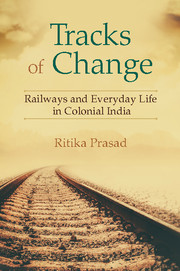Book contents
- Frontmatter
- Dedication
- Contents
- List of Tables and Figures
- Acknowledgements
- List of Abbreviations
- Introduction
- 1 The Nature of the Beast? An Elementary Logic for Third-Class Travel
- 2 Demand and Supply? Railway Space and Social Taxonomy
- 3 Crime and Punishment: In the Shadow of Railway Embankments
- 4 Railway Time: Speed, Synchronization, and ‘Time-Sense’
- 5 Contagion and Control: Managing Disease, Epidemics, and Mobility
- 6 Designing Rule: Power, Efficiency, and Anxiety
- 7 Marking Citizen from Denizen: Dissent, ‘Rogues,’ and Rupture
- Conclusion
- Bibliography
- Index
- About the Author
1 - The Nature of the Beast? An Elementary Logic for Third-Class Travel
Published online by Cambridge University Press: 05 September 2015
- Frontmatter
- Dedication
- Contents
- List of Tables and Figures
- Acknowledgements
- List of Abbreviations
- Introduction
- 1 The Nature of the Beast? An Elementary Logic for Third-Class Travel
- 2 Demand and Supply? Railway Space and Social Taxonomy
- 3 Crime and Punishment: In the Shadow of Railway Embankments
- 4 Railway Time: Speed, Synchronization, and ‘Time-Sense’
- 5 Contagion and Control: Managing Disease, Epidemics, and Mobility
- 6 Designing Rule: Power, Efficiency, and Anxiety
- 7 Marking Citizen from Denizen: Dissent, ‘Rogues,’ and Rupture
- Conclusion
- Bibliography
- Index
- About the Author
Summary
The people of India were unlikely to be railway passengers. So concluded the East India Company's Court of Directors in 1845, when faced with the first commercial proposal for building railways in colonial India. Arguing that India's population had been rendered immobile by poverty, a landscape of isolated habitations, and religious restrictions, the Court suggested that railway companies seek most of their profit here by transporting merchandise and livestock rather than people. Pointing to existing circuits of circulation and mobility, some interlocutors disagreed, arguing that railways would, in fact, attract passengers. However, for purposes of early railway planning, it was the Court's view that prevailed.
The Court's expectations notwithstanding, railway travel became rather popular. Though the increase in passengers was quite startling from the 1870s onwards, railways attracted people right from the start. Half a million travelled in the opening year—1853–54—even though only 35 miles of track was open at the time. Despite the disruption in railway construction during 1857–59, the number of passengers continued to grow. The 3.89 million who travelled in 1860 represented a 680 per cent increase over 1854. In 1870, by which time the colonial state had begun to involve itself directly in railway construction—while continuing to support and subsidize companies like the East Indian Railway (EIR) and the Great Indian Peninsular Railway (GIPR)—18.22 million passengers travelled across more than 4,500 miles of track. Over the next three decades, passenger figures catapulted, aided by the substantial expansion in the size of the railway network. In 1900, more than 175 million passengers traversed the roughly 25,000 miles of track open by then. By 1911, annual passenger traffic was over 389 million; statistically speaking, this meant that each person comprising India's population of 315 million was a railway passenger at least once that year (Figures 1.1 and 1.2).
- Type
- Chapter
- Information
- Tracks of ChangeRailways and Everyday Life in Colonial India, pp. 23 - 57Publisher: Cambridge University PressPrint publication year: 2015

